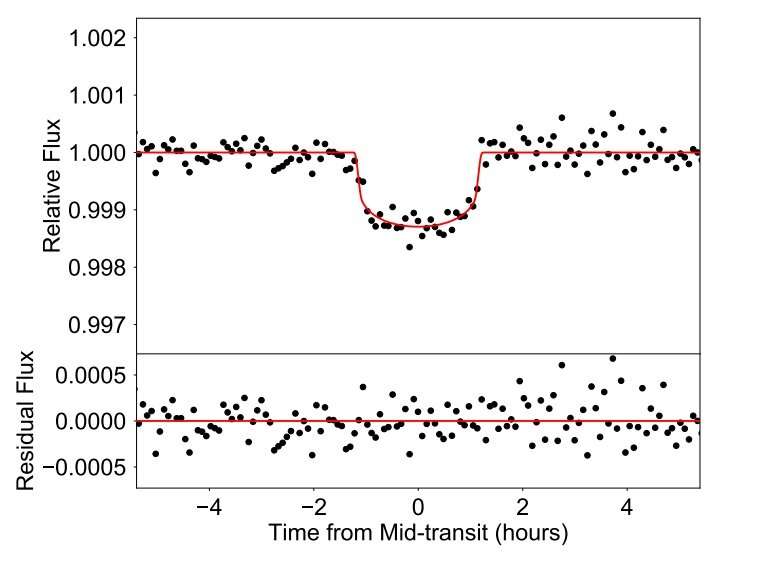June 22, 2023 report
This article has been reviewed according to Science X's editorial process and policies. Editors have highlighted the following attributes while ensuring the content's credibility:
fact-checked
preprint
trusted source
proofread
Astronomers discover new mini-Neptune exoplanet

An international team of astronomers reports the discovery of a new mini-Neptune exoplanet orbiting a nearby star. The newfound alien world, designated TOI-2018 b, is about two times larger and nine times more massive than the Earth. The finding was detailed in a paper published June 13 on the pre-print server arXiv.
NASA's Transiting Exoplanet Survey Satellite (TESS) is conducting a survey of about 200,000 of the brightest stars near the sun with the aim of searching for transiting exoplanets, ranging from small rocky worlds to gaseous giants. So far, it has identified nearly 6,700 candidate exoplanets (TESS Objects of Interest, or TOI), of which 350 have been confirmed to date.
Now, a group of astronomers led by Fei Dai of the California Institute of Technology (Caltech), has recently confirmed another TOI monitored by TESS as part of a systematic search for transiting planets among low-metallicity dwarf stars. They report that a transit signal has been identified in the light curve of TOI-2018 (also known as BD+29 2654)—a metal-poor K-dwarf star located some 91.4 light years away. The planetary nature of this signal was confirmed by follow-up observations.
According to the paper, TOI-2018 b has a radius of about 2.27 Earth radii and a mass of about 9.2 Earth masses, which suggests an Earth-like core with a hydrogen/helium envelope, or an ice-rock mixture. The planet orbits its host star every 7.44 days and its equilibrium temperature is estimated to be 652 K.
The researchers noted that taking into account the relatively huge mass of TOI-2018 b, this extrasolar world is close to the threshold (around 10 Earth masses or lower for a low-metallicity environment) for run-away accretion and hence giant planet formation. Therefore, the authors of the paper suppose that TOI-2018 b may be a planetary core that failed to undergo run-away accretion.
"It might seem strange that TOI-2018 b failed to undergo run-away accretion given the large core mass. It may be the case that TOI-2018 b did not have enough time to initiate run-away accretion before the [protoplanetary] disk dissipated," the astronomers explained.
Dai's team has also detected another object around TOI-2018, that may be an exoplanet. It is about 50% larger than the Earth and its mass is estimated to be not larger than 3.6 Earth masses. Follow-up observations are required in order to confirm planetary status of this object.
When it comes to the properties of the host star, it is about 40% smaller and less massive than the sun. The star, estimated to be 2.4 billion years old, has an effective temperature of 4,174 K and its metallicity was measured to be at a level of -0.58.
More information: Fei Dai et al, A Mini-Neptune Orbiting the Metal-poor K Dwarf BD+29 2654, arXiv (2023). DOI: 10.48550/arxiv.2306.08179
Journal information: arXiv
© 2023 Science X Network




















